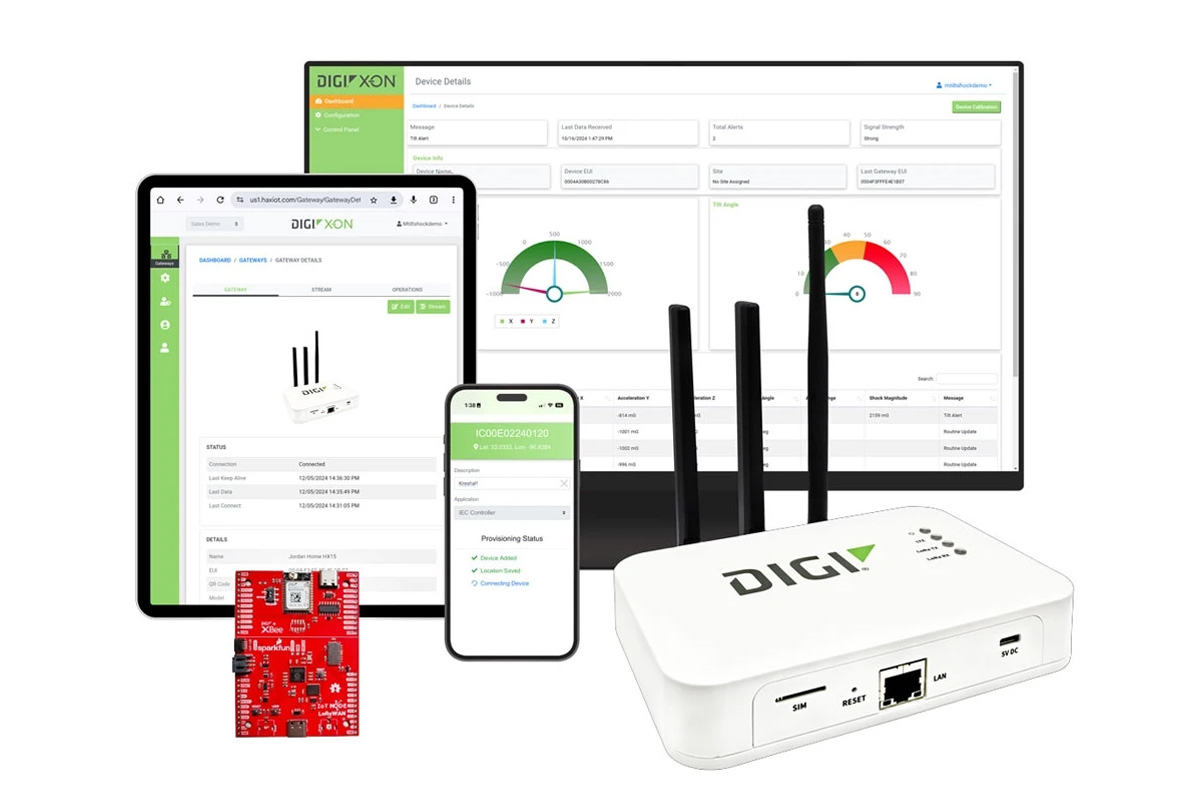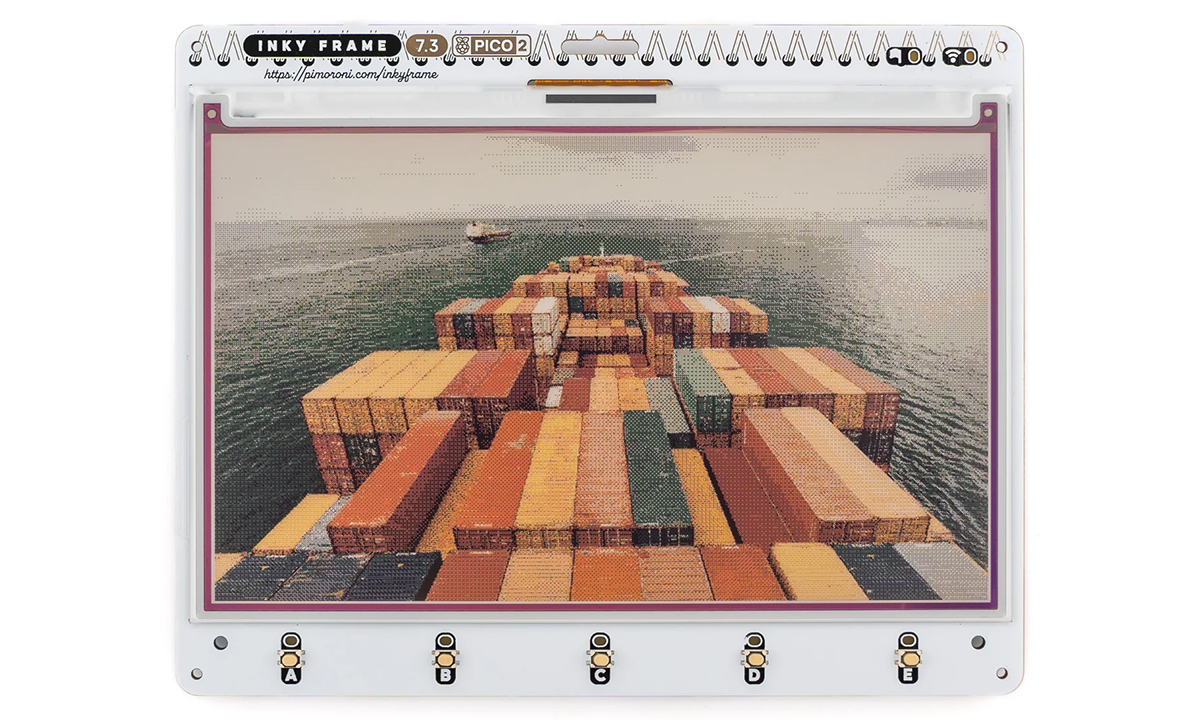SparkFun has recently released the Digi X-ON LoRaWAN development kit an all-in-one IoT development kit designed to simplify the setup and deployment of LoRa-based IoT systems. It includes the Digi HX15 Gateway, SparkFun IoT Node for LoRaWAN, and the ENS160/BME280 environmental sensor, enabling rapid prototyping and connectivity with the help of the Digi X-ON cloud platform. The SparkFun IoT Node is built around the Raspberry Pi RP2350 microcontroller, which features 16MB flash, 8MB PSRAM, multiple GPIOs, LiPo battery support, microSD storage, and USB-C connectivity. It also integrates the Digi XBee LR module for long-range LoRaWAN communication with pre-activated cloud connectivity. With an onboard Qwiic connector and Arduino support, this development kit is ideal for applications like industrial monitoring, environmental sensing, smart agriculture, remote data collection, and more. Digi HX15 gateway specifications Microprocessor – STMicro STM32MP157C MPU with dual-core Cortex A7 @ 650 MHz, Cortex-M4 @ 209 MHz with FPU/MPU, 3D […]
Open hardware RP2350B boards offer up to 16MB flash, 8MB PSRAM, microSD card slot, 48x GPIOs
Olimex has recently released the PICO2-XL and PICO2-XXL open-source hardware RP2350B development boards with up to 16MB flash, 8MB PSRAM, 48 GPIOs, a microSD card slot, and more. The main difference between the two boards is that the PICO2-XL includes 2MB of external QSPI Flash and a compact flat-bottom design, making it ideal for simpler, space-constrained projects. In contrast, the PICO2-XXL offers 16MB of QSPI Flash, 8MB of PSRAM, and a microSD card slot for expanded storage and performance, catering to more demanding applications like IoT and edge computing. Olimex PICO2-XL and PICO2-XXL specifications SoC – Raspberry Pi RP2350B MCU CPU Dual-core Arm Cortex-M33 @150MHz with Arm Trustzone Dual-core 32-bit Hazard3 RISC-V @ 150MHz Up to two cores can be used at the same time Memory – 520KB SRAM 8kB OTP storage Security – Secure boot Package – QFN-80; 10×10 mm Memory – 8MB PSRAM (PICO2-XXL only) Storage PICO2-XL – […]
CrowPanel Advance: ESP32-S3 displays with replaceable WiFi 6, Thread, Zigbee, LoRa, and 2.4GHz wireless modules
Elecrow’s CrowPanel Advance is a family of 2.8-inch to 7-inch ESP32-S3 WiFi and BLE displays that supports replaceable modules for Thread/Zigbee/Matter, WiFi 6, 2.4GHz, and LoRa (Meshtastic) connectivity. Those are updates of the CrowPanel (Basic) displays introduced last year. They feature an ESP32-S3-WROOM-1-N16R8 module soldered on the back plus headers taking ESP32-H2, ESP32-C6, SX1262 LoRa transceiver, or nRF2401 2.4GHz wireless MCU. CrowPanel Advance 7-inch specifications: Wireless Module – ESP32-S3-WROOM-1-N16R8 SoC – ESP32-S3 CPU – Dual-core LX7 processor with up to 240MHz Memory – 512KB SRAM, 8MP PSRAM Storage – 384KH ROM Wireless – WiFi 4 and Bluetooth 5.0 with BLE Storage – 16MB flash PCB antenna Storage – MicroSD card slot Display 7.0-inch IPS capacitive touchscreen display with 800×480 resolution (SC7277 driver) Viewing Angle: 178° Brightness: 400 cd/m²(Typ.) Color Depth – 16-bit Active Area – 156 x 87mm Audio Built-in microphone Speaker connector Wireless Expansion ESP32-H2 module with 802.15.4 radio […]
Seeed Studio XIAO Plus series adds more GPIOs through castellated holes
In response to community feedback for more I/O options, Seeed Studio has recently launched the Seeed Studio XIAO Plus series with 23 castellated mounting pins (20 GPIOs, 3 power pins) and improved back solder points, improving compatibility with carrier boards for complex projects. The new series includes the XIAO ESP32S3 Plus, XIAO nRF52840 Plus, and XIAO nRF52840 Sense Plus which are direct upgrades of the XIAO ESP32S3, XIAO nRF52840 BLE, and XIAO nRF52840 Sense boards. The new design allows for easier assembly and scalable production, with double the I/O options. XIAO ESP32S3 Plus The Seeed Studio XIAO ESP32S3 Plus is a compact development board with a total of 23 pins on the board out of which 11 are through-hole GPIO pins 9 additional SMD castellations GPIO pins and 3 through-hole are power pins. The board is built around an ESP32-S3 MCU so it has 2.4GHz WiFi and BLE 5.0 connectivity. Other […]
$12 Plant Bot is an ESP32-C3 soil sensor and pump driver for fully automated indoor plant care
The Plant Bot is an open-source, Internet-enabled plant monitor powered by the ESP32-C3 microcontroller and integrating a corrosion-resistant capacitive moisture soil sensor and a pump driver on a single printed circuit board, eliminating the need for additional cabling. The Plant Bot is designed to automate indoor plant care by combining moisture sensing, light sensing, and pump activation. It can be powered via USB or a single coin cell battery which lasts up to a week with daily updates. An onboard multi-color LED visually represents the current soil condition, ranging from red (dry) to blue (moist). The “Soil Level” line on the board indicates the maximum depth to which the sensor or device should be inserted into the soil. According to the maker, the Plant Bot will remain unaffected by corrosion if the soil level does not exceed this line. Other solutions we’ve covered with a soil sensor usually separate the […]
Inky Frame 7.3″ is a 7-color ePaper display powered by a Raspberry Pi Pico 2 W
The Inky Frame 7.3″ is a Pico 2 W ePaper display featuring a 7.3-inch E Ink screen with 800 x 480 resolution and 7-color support. Other features include five LED-equipped buttons, two Qwiic/STEMMA QT connectors, a microSD card slot, and a battery connector with power-saving functionality. This Pico 2 W ePaper display is ideal for low-power applications such as home automation dashboards, sensor data visualization, and static image displays. E Ink technology ensures energy efficiency by consuming power only during screen refreshes while retaining images when unpowered. Flexible mounting options and included metal legs make it suitable for various setups. Previously, we covered the Waveshare 4-inch Spectra, a six-color ePaper display, along with other modules like the Inkycal v3, Inkplate 4, EnkPi, Inkplate 2, and more. Check them out if you’re interested in exploring these products. The Inky Frame 7.3″ specifications: Wireless module – Raspberry Pi Pico 2 W SoC […]
Pico W5 is a Raspberry Pi Pico 2 W alternative with RP2350 MCU, dual-band WiFi 4, 8MB flash
The Pico W5 is a Raspberry Pi RP2350 development board providing an alternative to the official Raspberry Pi Pico 2 W with dual-band (2.4GHz/5GHz) WiFi 4 and Bluetooth 5.0 connectivity through a B&T BW16 wireless module. Besides dual-band WiFi, there are a few other small changes compared to the Raspberry Pi Pico 2 W, including a USB Type-C connector, a larger 8MB flash, and a Reset button. As far as I know, it’s the first RP2350 board with 5GHz WiFi, as other RP2350 boards with WiFi, such as the Challenger+ RP2350 WiFi6/BLE5 and Pimoroni Pico Plus 2 W, only support 2.4GHz WiFi. Pico W5 specifications: SoC – Raspberry Pi RP2350 CPU Dual-core Arm Cortex-M33 @ 150 MHz with Arm Trustzone, Secure boot and Dual-core RISC-V Hazard3 @ 150 MHz Only two cores can be used at any given time Memory – 520 KB on-chip SRAM Security 8KB of anti-fuse OTP […]
Waveshare launches three RP2350 USB-C development boards with castellated design, battery support, built-in Ethernet port
Waveshare has announced four new USB-C and USB-A development boards based on the Raspberry Pi RP2350 MCU: the Waveshare RP2350-Plus dev board, the Waveshare RP2350-Zero Mini dev board, the Waveshare RP2350-ETH Mini dev board, and the Waveshare RP2350-GEEK USB dev board. The RP2350-Plus is a low-cost, high-performance Pico-like development board with the RP2350 MCU, various I/O, battery support, USB Type-C, and compatibility with Raspberry Pi Pico modules. The RP2350-Zero Mini is another compact dev board with castellated pins, 29 GPIOs, USB Type-C, PIO, and versatile peripheral support, ideal for IoT, robotics, and embedded systems. The RP2350-ETH Mini dev board has Ethernet support and various GPIO functionalities, making it ideal for IoT development. Like any other RP2350 board, the Waveshare RP2350 boards support C/C++ and MicroPython SDKs with drag-and-drop firmware flashing via USB mass storage. Waveshare RP2350-Plus development board The Waveshare RP2350-Plus is a low-cost development board that comes in a […]










